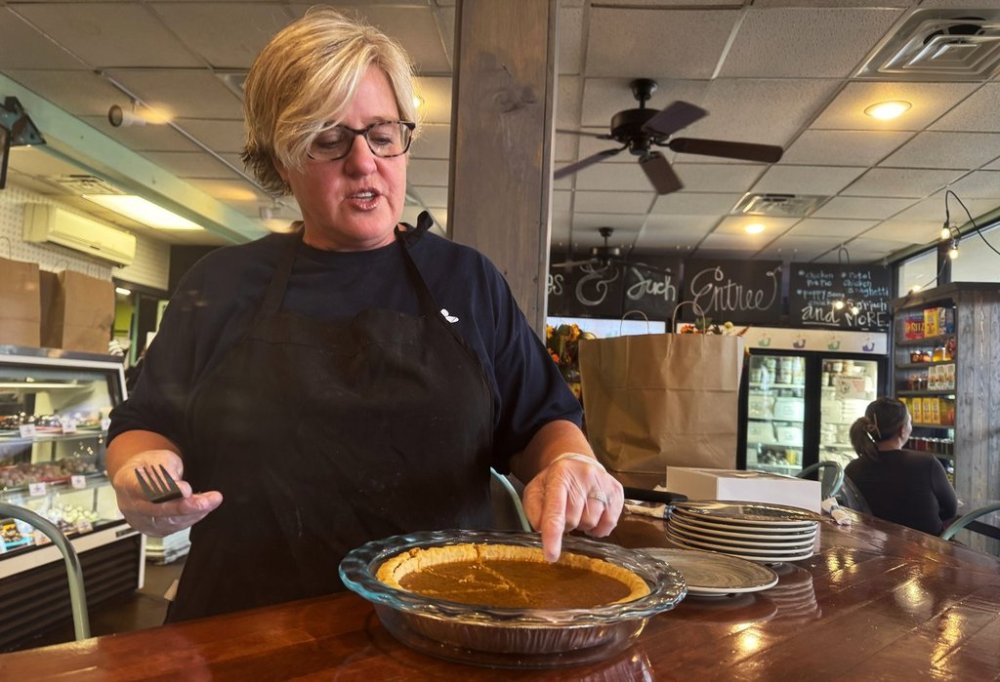Sweet potato or pumpkin? The Thanksgiving pie debate
Advertisement
Read this article for free:
or
Already have an account? Log in here »
To continue reading, please subscribe:
Monthly Digital Subscription
$0 for the first 4 weeks*
- Enjoy unlimited reading on winnipegfreepress.com
- Read the E-Edition, our digital replica newspaper
- Access News Break, our award-winning app
- Play interactive puzzles
*No charge for 4 weeks then price increases to the regular rate of $19.00 plus GST every four weeks. Offer available to new and qualified returning subscribers only. Cancel any time.
Monthly Digital Subscription
$4.75/week*
- Enjoy unlimited reading on winnipegfreepress.com
- Read the E-Edition, our digital replica newspaper
- Access News Break, our award-winning app
- Play interactive puzzles
*Billed as $19 plus GST every four weeks. Cancel any time.
To continue reading, please subscribe:
Add Free Press access to your Brandon Sun subscription for only an additional
$1 for the first 4 weeks*
*Your next subscription payment will increase by $1.00 and you will be charged $16.99 plus GST for four weeks. After four weeks, your payment will increase to $23.99 plus GST every four weeks.
Read unlimited articles for free today:
or
Already have an account? Log in here »
FLOWOOD, Miss. (AP) — They’re both round, orange and probably bad for your health, but which is the better Thanksgiving dessert: pumpkin or sweet potato pie? For most people, the answer likely depends on where they’re from.
The two Thanksgiving favorites have more in common than not. They’re similar in color, taste and texture, and derived from European carrot pie. Those similarities make them all the easier to compare.
“Pumpkin,” said Lori Robinson, a customer at Sugar Magnolia Takery in Flowood, Mississippi. “My mom cooks it every Thanksgiving, Christmas, every time. It’s way better than sweet potato.”

Unlike some bakeries in the area, Sugar Magonlia Takery makes both pumpkin and sweet potato pies.
Owner Elizabeth Arnold said the main difference between the pies in her bakery comes down to spice. Sweet potato is sweeter, made with white and brown sugar. Pumpkin pie is less sweet and spicier.
“Sweet potato pie. All day,” said Xavier Pittman, another customer.
At Arnold’s bakery, sweet potato tends to outsell pumpkin.
That’s not surprising in a southern bakery, explained Adrian Miller, a culinary author known as the “Soul Food Scholar.”
Sweet potato pie, he said, is particularly popular in the South, where sweet potatoes have deep roots in the region’s culture, economy and painful past.
“If there were to be a Mount Rushmore of soul food desserts, sweet potato pie would definitely be there,” Miller said.
Pumpkin pie, while ubiquitous, is more often associated with the northern part of the country.
The stereotypes boil down to this: Pumpkin pie is favored by white northerners while sweet potato pie is a favorite among Black southerners. But for culinary historian and author Michael W. Twitty, the issue is more nuanced.
With both desserts ingrained in American history, tradition and culture, the debate over which is better, Twitty argues, is really about identity.
“We can have fun with good-natured ribbing between regions and cultures,” Twitty said. “At the same time, don’t let it get too serious to the point where it’s like hard, fast markers of who you are, who I am, who we are.”
Raised in Washington, D.C., Twitty didn’t grow up in the Deep South. But the South, he said, has grown up in him. His family’s southern roots stretch back to the 17th century.
“Everybody would always bring like two homemade sweet potato pies,” Twitty said of his childhood Thanksgivings.
The intertwining of sweet potatoes and southern Black culture began with slavery. Sweet potatoes were a staple for many enslaved people in the Americas, Twitty said. It was an accessible, familiar food, similar to the yams and cassava that make up a cornerstone of African cuisine.
Enslaved people are credited with perfecting the sweet potato pie recipe, though Europeans are thought to be the first to attempt such a delicacy.
Some believe slavery is the reason sweet potato pie didn’t take off in the North. An abolitionist movement advocated boycotting goods produced by enslaved people but, Twitty said, the answer is likely simpler: access.
Sweet potatoes and pumpkins were both available in the South. In the North, however, early Americans didn’t have much access to the orange sweet potatoes we think of today, Miller said. Instead, northern sweet potatoes had white flesh and a more mealy texture.
With limited access to sweet potatoes in the North, pumpkin likely reigned supreme. The tradition of pumpkin pie goes back centuries to the colonial period, Miller said. A recipe for pumpkin pie was included in the nation’s first cookbook, written in 1796 by Amelia Simmons.
While there may be some truth to the culinary divide, Twitty said the stereotypes don’t hold up in many communities. Miller, who also has southern ancestry, said he grew up eating pumpkin and sweet potato pie on Thanksgiving.
“There will also be somebody, every single day, every single year who will break the rules,” Twitty said.

